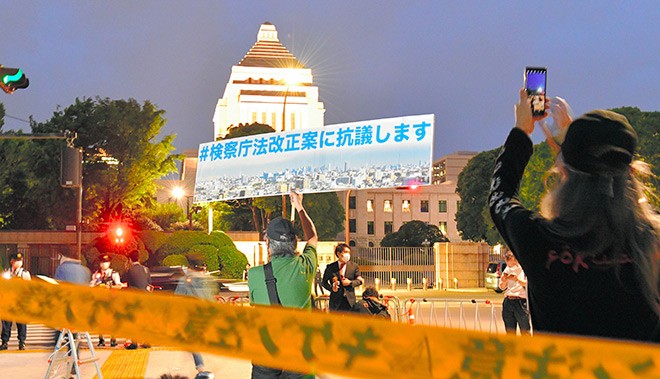[Blog] Blind on the Left Eye? #kensatsuchō, a Case of Massive Anti-Abe Computational Propaganda?
Fabian Schäfer
In an article published in Asia-Pacific Focus Japan Journal, I presented recent academic and journalistic findings that have brought to light several cases of computational propaganda on Japanese social media. Although I couldn’t provide bullet-proof evidence of who was behind this activity, increasing circumstantial evidence allows for the assumption that certain factions of the LDP were behind this. Naturally, this rose criticism why I wasn’t also looking into the activities from the parties from the liberal-leftist political spectrum. The question if this kind of criticism does fall into the category of “whataboutist” discursive strategies of the New Right to deceit from the original topic of the debate, the claim that there is always rotten apples on both sides, to say it in the slightly altered words of a former US president, is based on false equivalences. This becomes more than clear if you compare the strategies of online political activism from the left and the right: “left-wing actors operate primarily through ‘hashtag activism’ and offline protest, right wing activists manipulate legacy media, migrate to alternative platforms, and work strategically with partisan media to spread their messages” (Freelon et al. 2020: 1197) – and they are very well versed in methods of computational propaganda, including the strategic employment of botnets and orchestrated dissemination of racist and misogynist hate speech.
One might think of various reasons why evidence that the political left is employing similar strategies has not surfaced. On the one hand, as the ruling party, the LDP is currently under higher scrutiny from investigative journalism, judicial prosecution, and academic research than the opposition parties. Naturally, this means that the statistical probability is significantly higher that questionable activities such as the ones described above are coming to light. Accordingly, if other parties were employing or tolerating computational propaganda as well, it would only be a matter of time before similar cases were disclosed. On the other hand, the current opposition parties were much slower than the LDP in adapting to the revised electoral law of 2013 and adopting efficient online tactics in their campaign strategies, making them less likely to be engaged in computational political propaganda to the same extent as the LDP (Williams and Miller 2016).
Be that as it may, there have also been instances of massive online mobilization against certain policies and actions by the LDP under Abe’s leadership. One was the massive online and offline protests against Abe’s intent to revise the Public Prosecutor’s Office Law in summer 2020. When Abe presented his plan to change the law and extend the retirement age from 63 to 65, it caused an unexpected outcry on social media. Many famous public figures, including actors, musicians, and television celebrities, weighed in together with a large crowd of Twitter users, spreading the hashtag “I oppose the revision of the Public Prosecutor’s Office Law” (#kensatsuchō hōkaiseian ni kōgi shimasu). Critics considered Abe’s plan a “use of power for personal benefit,” as the retirement extension would have paved the way for Kurokawa Hiromu, chief of the Tokyo High Prosecutor’s Office, to be “promoted to the post of public prosecutor general, or head of the Supreme Public Prosecutor’s Office” (Asahi shinbun AJW 2020a). Viewing the proposed revision as an interference that would erode the separation of powers and the neutrality and independence of prosecutors, Twitter users expressed their opposition in more than 6 million tweets and retweets in only a few days (May 9–18).
When questioned about the tweets in a Lower House plenary session, Abe responded that he refrains “from commenting on various opinions on the internet on behalf of the government” (Asahi shinbun AJW 2020b). Yet only five days later, on May 18, Nikai Toshihiro, secretary-general of the LDP, announced a delay in the revision plan, stating, “We cannot push forward without the support and understanding of the public” (Asahi shinbun AJW 2020a).

Demonstrators gather May 15, 2020, outside the Diet building to protest revisions to the Public Prosecutor’s Office Law. Source: https://www.asahi.com/ajw/articles/13378891
According to a report in the Japan Times on June 18, 2020, the plan to raise the retirement age of prosecutors was in fact related to the case of Kawai Katsuyuki. The newspaper noted that Kawai’s arrest marked “a new phase in a legal showdown between prosecutors and the Prime Minister’s Office, whose relations became strained over the administration’s initial eagerness to appoint” Kurokawa (Sugiyama 2020). The Japan Times said the aim of Abe’s cabinet was to keep Kurokawa, a close ally of Abe, in his position until August (despite having already hit the retirement age of 63) in order “to help shield the administration from damaging investigations—including the probe into the Kawais” (Sugiyama 2020). It is important to know that although the investigation was originally to be led by prosecutors in Hiroshima, it was at that time already expected that the Tokyo District Public Prosecutor’s Office would take over because of the sensitive political nature of the investigation (Sugiyama 2020). However, after Kurokawa had to step down when it was disclosed that he had played mahjong for money with newspaper reporters in the midst of the coronavirus lockdown, “Makoto Hayashi, then the head of the Nagoya High Public Prosecutor’s Office, took over Kurokawa’s position in Tokyo and is believed to be a leading candidate for the prosecutor-general position, a much less desirable scenario for the Abe administration” (Sugiyama 2020).
Naturally, speculations arose that the enormous number of tweets protesting the revision of the Public Prosecutor’s Office Law was caused by an orchestrated computational campaign against Abe. However, according to an in-depth analysis of tweets by Toriumi Fujio, a computational social scientist at the University of Tokyo’s Graduate School of Engineering, bots did not play a decisive role in the massive dissemination of these tweets and retweets (Toriumi 2020). Running various analytical tests on the data he had collected from May 8 to 11—a total of 4,732,743 tweets (564,065 tweets excluding retweets) sent from 588,065 different accounts—Toriumi arrived at the conclusion that (a) twitter accounts that posted only one tweet made up 80% of tweets and (b) only 0.7% of the Twitter accounts in his dataset were newly created. Both results allow for the validated assumption that fake accounts and bots, usually an indicator of an orchestrated computational campaign, did not have a significant part in this incident.
Sources:
Asahi shinbun AJW. 2020a. “Abe Forced to Call Off Bid to Extend Retirement Age of Prosecutors.” May 18. Available at: https://www.asahi.com/ajw/articles/13383193. Accessed May 20, 2020.
Asahi shinbun AJW. 2020b. “LDP Brushes Off Millions of Protest Tweets over Prosecutor.” May 13. Available at: https://www.asahi.com/ajw/articles/13370498. Accessed May 15, 2020.
Freelon Deen, Marwick Alice, und Kreiss Daniel. „False equivalencies: Online activism from left to right“. Science 369, Nr. 6508 (4. September 2020): 1197–1201. https://doi.org/10.1126/science.abb2428.
Sugiyama, S. 2020. “Former top Abe aide and wife arrested in vote-buying scandal.” Japan Times, June 18. Available at: https://www.japantimes.co.jp/news/2020/06/18/national/crime-legal/katsuyuki-anri-kawai-arrested-vote-buying/. Accessed November 17, 2021.
Toriumi, F. 2020. “#Kensatsuchō-hō kaisei-an ni kōgi shita hito ha hontō ha dono kurai ita no ka” [How many people were really protesting against the revision of the Prosecutor’s Law?]. tori, May 11. Available at: https://note.com/torix/n/n5074423f17cd. Accessed November 21, 2021.
Williams, J. A., and D. M. Miller. 2016. “Netizens Decide 2014? A Look at Party Campaigning Online.” In Japan Decides 2014: The Japanese General Election, edited by R. J. Pekkanen, S. R. Reed, and E. Scheiner, 144–152. London: Palgrave Macmillan. doi:10.1057/9781137552006_12.
